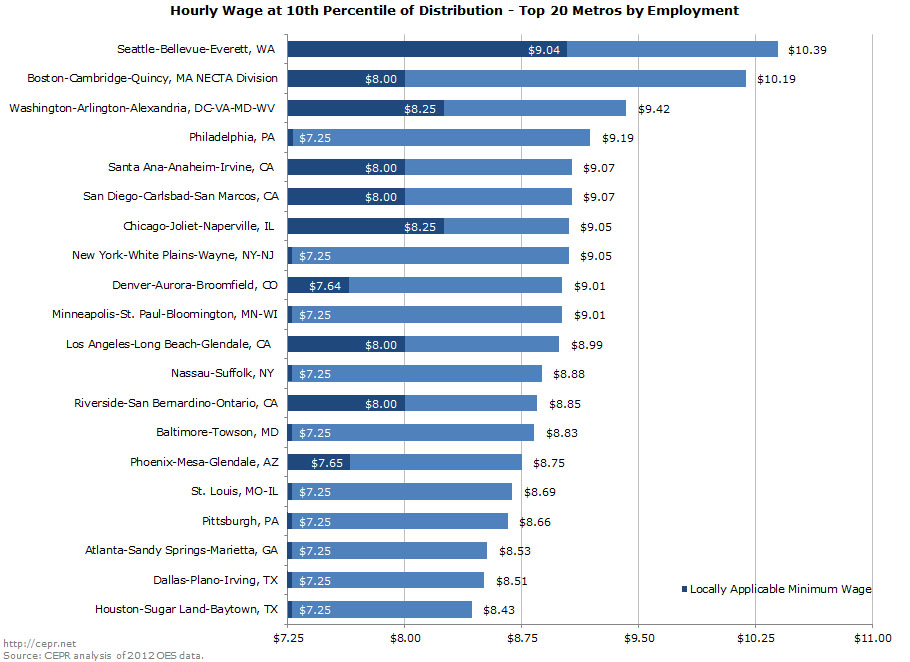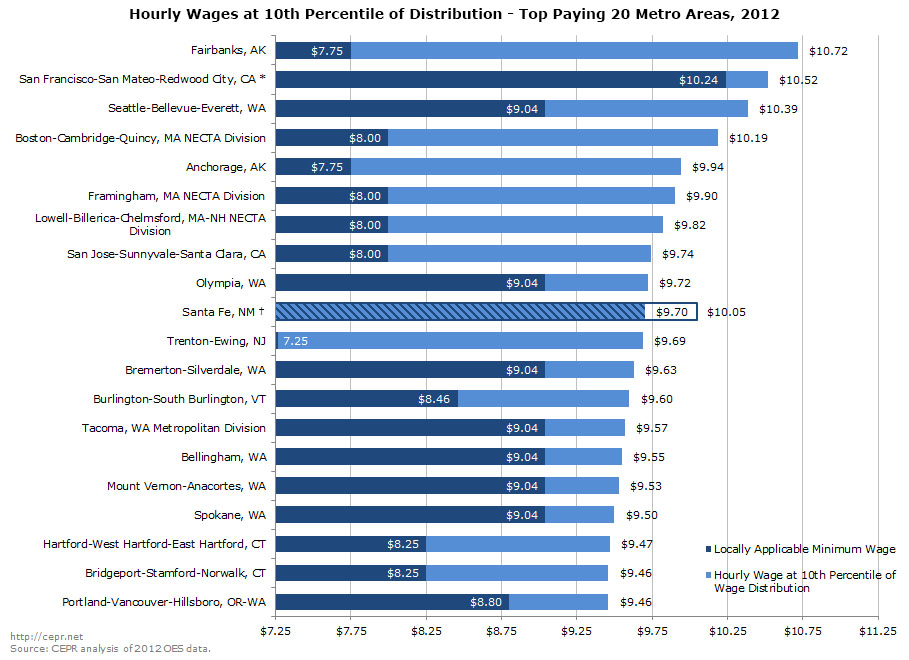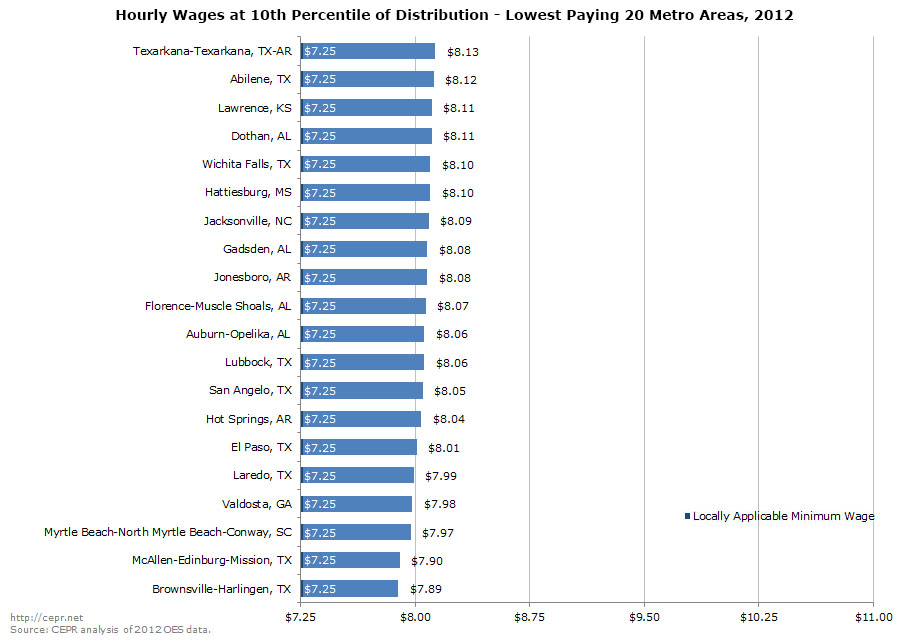January 27, 2014
In recent months, the minimum wage has moved to the center of the economic policy debate. Proposals for minimum-wage increases are being introduced at the local, state, and national levels of government. Nationally, President Obama is working alongside Congressional Democrats on a push to raise the federal minimum wage from its current level of $7.25 to $10.10 by 2016.
At the state level, 20 states and the District of Columbia have minimum wages above the federal level, and on January 1, 2014, 13 states raised their minimum wage, with California set to follow suit with an increase to $9 in July. Of these 14 state increases, 9 are automatic adjustments based on indexing the value of the minimum wage to the cost of living, while 4 (NJ, CT, NY, RI) are the product of either ballot-measures or legislative action.
City governments have also taken action on this issue. Last year in San Jose, CA, voters approved a measure raising the minimum wage to $10 an hour, including an annual cost of living adjustment that will keep the San Jose wage above the California-wide minimum. Likewise, in SeaTac, WA, voters approved a measure increasing the minimum wage to $15 for transit and hotel workers, a particularly notable change given that Washington state already has the highest state-wide minimum wage in the nation. Over the past few months, fast food workers held strikes in 130 US cities demanding an increase in their wages. Most recently, in the District of Columbia, Mayor Vincent Gray signed a bill increasing the minimum wage from $8.25 to $9.50, and eventually to $11.50 by 2016.
Despite of all the energy behind these initiatives, more than half of US states follow the federal minimum exactly – some of them merely by default as they lack any minimum wage legislation of their own. And wages vary widely across different states and different regions. For every San Francisco, Boston, or Seattle – where most of even the lowest paid workers receive over $10 an hour – there are cities such as El Paso TX, Shreveport LA, and Athens GA, where thousands of workers barely earn $8.00 an hour.
The 2012 Occupational Employment Statistics data released by the BLS gives a detailed picture of just how much wage rates vary across the country for workers at the 10th percentile of the wage distribution. (The 10th percentile worker earns more than 10 percent of workers, but less than 90 percent of workers.)
The chart below shows the hourly wage at the 10th percentile of the wage distribution for the 20 largest American metropolitan areas by total employment. These cities are ranked by their wage rate at the 10th percentile, with the locally applicable minimum wage indicated by the dark blue overlay.
The above figure suggests (but, of course, does not prove) a solid correlation between the local minimum wage and the wage rate at the 10th percentile. What is interesting in the above data is that the 10th percentile wage figure for all of the above cities consistently exceeds the local minimum wage by $1.00 or more (the only metros where this does not hold are Chicago-Joliet-Naperville and Riverside-San Bernadino-Ontario, which are $0.80 and $0.85 ahead of their local minimum respectively). We do not find a clustering of the wage distribution at or slightly above the local minimum wage, even in metro areas with relatively high minimum wage levels, such as the DC and Seattle metro areas. This finding gives anecdotal support for the hypothesis that the minimum wage exerts some degree of upward pressure on local wages, instead of merely serving as a hard floor on the price of labor.
To make the point about the connection between the minimum wage and the 10th percentile wage in a different way, below, I have graphed the same data in a scatter plot, with the local minimum wage along the horizontal axis, and the 10th percentile wage rate on the vertical axis. In this format, the positive association between these two variables is even clearer (a line of best fit is presented in dark blue).
Expanding the scope of the analysis to all metro areas in the US, the next chart shows the 20 American metropolitan areas with the highest wage rate at the 10th percentile level.
* The city of San Francisco had a minimum wage of $10.24 in 2012, higher than California’s state-wide minimum.
† The city of Santa Fe also has a city specific minimum wage, which was $9.85 prior to March 1st, 2012, after which the minimum wage rose to $10.29 an hour – the figure of $10.04 used here is a weighted average of these numbers over the OES sampling period. The anomalous result above, where the minimum wage exceeds the 10th percentile wage, is most likely the product of a combination of exemptions, non-compliance, and challenges inherent in the sampling methods used in the OES survey.
Among the 20 metro areas with the highest 10th percentile wage rate, seven are (primarily) in Washington state, the state with the highest minimum wage at $9.04 in 2012. Only one of the metros listed in the top 20 followed the federal minimum (Trenton, NJ).
By contrast, the following chart shows the other end of the same distribution – the 20 metro areas with the lowest wage at the 10th percentile level. All of the metropolitan areas in this second figure abide by the Federal minimum wage level of $7.25.
Each of the above metropolitan areas is subject to its own local political and economic factors, so we should be hesitant in drawing broad conclusions from the above data. Yet this discussion does make clear one aspect of the picture – there is a high degree of variability in the wage rate of low paid workers across the country, not only between states, but also between cities.
(Brief Methodological Note: When reading the two charts presented above, keep in mind that the 2012 OES data measures wage and employment information garnered from surveys distributed to about 62% of US establishments. For smaller metro areas, the OES sometimes averages data from the year(s) past in order to reduce sampling error enough to produce a reliable estimate. Additionally, because the 2012 data is based on surveys distributed in November, 2011 as well as in May 2012, some of the wage data above was collected before the reported minimum wage went into effect. At the beginning of 2012, Vermont increased its minimum wage from $8.15 to $8.46, Washington state increased its minimum wage from $8.67 to $9.04, and Oregon increased its minimum wage from $8.50 to $8.80.)









